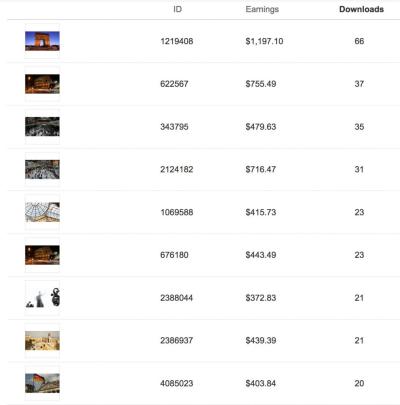If you’ve ever dreamed of turning your passion for photography or digital art into a side hustle or even a full-time income, Shutterstock might just be the platform for you. As one of the largest stock image marketplaces out there, Shutterstock provides an excellent opportunity for creators to showcase their unique visuals and earn royalties every time someone downloads their work. Whether you’re a professional photographer or an enthusiastic hobbyist, understanding how to navigate
Understanding Shutterstock’s Requirements for Contributors

Before you start uploading your images, it’s important to understand what Shutterstock expects from its contributors. Their goal is to maintain a high-quality, diverse, and legal collection of images that appeals to a broad audience. Here are some key requirements and tips to keep in mind:
- Image Quality: Shutterstock prioritizes sharp, well-exposed, and properly composed images. Avoid blurry or noisy photos. Use good lighting and focus on clarity to meet their standards.
- Technical Standards: Files should be in JPEG format with a minimum of 4 megapixels (generally around 2000 pixels on the shortest side). Images must be in RGB color space, and avoid heavy compression that causes artifacts.
- Legal and Model Releases: Ensure that you have the rights to all content, including any recognizable people, private property, or trademarks. For images featuring identifiable individuals, a signed model release is required. For property or branded items, a property release may be necessary too.
- Content Guidelines: Shutterstock prefers original, creative, and high-quality images. They do not accept spam, watermarked, or heavily edited images that don’t look natural. The content should be relevant and suitable for commercial or editorial use.
- Metadata and Keywords: Properly keyword your images with relevant, specific tags to help users find your work. Accurate descriptions and titles improve your chances of sales.
Getting familiar with these guidelines will not only help you get approved as a contributor but also increase your chances of earning. Keep in mind that Shutterstock reviews submissions to ensure they meet their standards, so take your time to prepare and upload only your best work. Once approved, you’ll be on your way to sharing your unique images with a global audience and earning royalties along the way.
Tips for Creating Unique and High-Quality Images

Creating images that stand out on Shutterstock isn’t just about snapping a quick shot. It’s about capturing something fresh, compelling, and of course, technically perfect. Here are some tips to help you craft images that not only catch the eye but also have a higher chance of selling.
Focus on Originality: Think about what hasn’t been overdone. Instead of recreating popular themes, try to find a new angle or perspective. For example, instead of a typical city skyline, shoot from a unique vantage point or capture a moment that tells a story.
Invest in Good Equipment: High-quality images need clear, sharp details. While you don’t need the most expensive camera out there, a decent DSLR or mirrorless camera with good lenses can make a big difference. Pay attention to lighting, focus, and stabilization.
Master Composition: Use principles like the rule of thirds, leading lines, and framing to make your images more engaging. Keep backgrounds clean and uncluttered unless the clutter is intentional and adds to the story.
Lighting is Key: Natural light is often your best friend. Shoot during golden hours — shortly after sunrise or before sunset — for warm, soft light. If shooting indoors, consider investing in affordable lighting kits to ensure consistent, professional-looking results.
Capture Emotions and Authentic Moments: People connect with genuine emotions. Whether it’s a candid shot of someone laughing or a peaceful landscape, authentic moments resonate more and can differentiate your portfolio.
Stay Updated with Trends: Browse Shutterstock’s trending collections to see what’s popular. Incorporate current themes while adding your unique twist. Combining trendiness with originality is a winning combo.
Remember, the key is to create images that tell a story or evoke a feeling. When you combine technical quality with originality, your photos will stand out to buyers and increase your chances of making sales.
Preparing Your Images for Submission
Once you’ve captured your stunning, high-quality images, the next step is preparing them properly for submission to Shutterstock. Proper preparation not only helps your images get approved faster but also ensures they look professional and appealing to buyers.
Follow Shutterstock’s Technical Requirements: Before uploading, double-check Shutterstock’s guidelines. Typically, they require images to be:
- In JPEG format
- Color mode: RGB
- Minimum resolution: 4 megapixels (for most categories)
- Maximum file size: around 50MB
Make sure your images meet these specs to avoid rejection.
Optimize Image Quality: Use photo editing software like Adobe Lightroom or Photoshop to do the following:
- Adjust Brightness and Contrast: Ensure your images are vibrant but natural-looking.
- Sharpen Details: Slightly sharpen your images to enhance clarity.
- Remove Noise: Clean up any grain or digital noise, especially in low-light shots.
- Correct Colors: Make sure colors are accurate and appealing.
Crop and Resize: Crop your images to improve composition if needed, and resize to meet Shutterstock’s resolution requirements. Always keep the aspect ratio consistent to avoid distortion.
Remove Watermarks and Branding: Ensure your images are free of any watermarks, logos, or branding unless they are part of the subject and permitted.
Metadata and Keywords: Adding detailed keywords and descriptions helps your images get discovered. Be descriptive and specific, including relevant terms that potential buyers might search for.
| Preparation Step | Why It’s Important |
|---|---|
| Technical adjustments | Ensures your image meets platform specs and looks professional |
| Quality enhancement | Makes your images more appealing and market-ready |
| Metadata addition | Improves discoverability in searches |
Finally, give your images a last review before submission. Check for any imperfections, ensure all metadata is filled out accurately, and confirm they adhere to Shutterstock’s guidelines. Proper preparation can make a huge difference in getting your images accepted and making sales.
Uploading and Tagging Your Images Effectively
Once you’ve created a collection of stunning, high-quality images, the next step is getting them onto Shutterstock. But simply uploading your pictures isn’t enough — how you upload and tag them can make a huge difference in how often they get found and purchased.
First things first: when you’re ready to upload, make sure each image is in the correct format and resolution. Shutterstock prefers files in JPEG format, with a minimum of 4 megapixels, and the images should be sharp, well-lit, and free of noise or distractions.
Now, onto the crucial part — tagging. Think of tags as the keywords that help buyers discover your images. The more relevant and specific your tags are, the higher the chance your image will appear in search results. For example, if you upload a photo of a mountain sunrise, your tags might include mountain, sunrise, nature, landscape, and outdoor.
Here are some tips for effective tagging:
- Use accurate keywords: Only include tags that truly describe your image.
- Be specific: Instead of just “flower,” use “pink peony” or “yellow sunflower.”
- Include relevant concepts: Think beyond the obvious—consider moods, seasons, or activities.
- Avoid over-tagging: Don’t stuff your image with irrelevant tags; it can hurt your search rankings.
- Check trending tags: Browse Shutterstock or other stock sites to see what tags are popular in your niche.
Additionally, write a compelling, keyword-rich title and description for each image. This not only helps with searchability but also gives buyers context about your work. Keep descriptions clear and concise, highlighting the main themes or uses of your image.
Remember, quality over quantity is key. Upload images that meet Shutterstock’s standards, tag them thoughtfully, and provide detailed descriptions. This synergy boosts your chances of making sales and building a reputable portfolio.
Promoting Your Shutterstock Portfolio to Increase Sales
Once your images are uploaded and properly tagged, the next big step is making sure people see them. Promoting your Shutterstock portfolio is essential to attract more buyers and increase your sales. Think of it as marketing your work to the right audience.
Start with leveraging social media. Share your best images on platforms like Instagram, Pinterest, Facebook, and LinkedIn. Use relevant hashtags and engaging captions to draw attention. For example, if you upload a stunning cityscape, share it with hashtags like cityscape, urbanphotography, or stockimages.
Join online communities and forums related to photography and stock imagery. Platforms like Reddit, photography Facebook groups, or specialized forums are great places to share your work, gather feedback, and connect with potential buyers or collaborators.
Build a personal website or blog showcasing your portfolio. This not only helps with branding but also gives you a central hub where clients can learn more about you and your work. Optimize your site for search engines with relevant keywords to attract organic traffic.
Collaborate with bloggers, content creators, and small businesses. Offer your images for their projects or create custom content. This not only generates income but also increases exposure for your portfolio.
Consider using email marketing to stay in touch with your audience. Regularly send updates, new images, or special offers to your subscribers. Building an engaged email list can turn casual visitors into loyal customers.
Finally, stay consistent and patient. Promotion takes time, but as your visibility increases, so will your sales. Keep uploading fresh content, engage with your audience, and stay updated on Shutterstock trends. The more proactive you are in promoting your work, the more likely you are to turn your photography passion into a steady income stream.
Maximizing Earnings with Exclusive and Non-Exclusive Content
When you’re diving into the world of selling images on Shutterstock, one of the key decisions you’ll face is whether to go exclusive or non-exclusive with your content. Both options have their perks and considerations, so understanding them can help you maximize your earnings.
Exclusive Content means you grant Shutterstock the sole rights to sell your images. In exchange, Shutterstock often offers higher royalty rates—sometimes up to 40% of the sale price. The upside? If you have a portfolio of high-quality, unique images, going exclusive can significantly boost your income per download. Plus, exclusive contributors are often featured more prominently, giving your work increased visibility.
However, there are some things to keep in mind:
- You can’t sell the same images elsewhere; your work is tied to Shutterstock only.
- It’s best suited for images you plan to keep exclusive, especially if they have high commercial potential.
- It requires commitment—if you want to sell the same images on other platforms later, exclusivity isn’t the way to go.
Non-Exclusive Content, on the other hand, allows you to sell your images on multiple platforms. While the royalty rate might be slightly lower—generally around 15-30%—you have the flexibility to maximize your earnings by reaching a broader audience.
Here’s why non-exclusive might be the right choice:
- You retain full rights to your images and can sell them elsewhere, increasing your income streams.
- If you’re just starting out or testing new ideas, non-exclusive offers more freedom.
- You can decide which images to keep exclusive and which to sell non-exclusively, giving you control over your portfolio.
Tips for maximizing earnings:
- Mix and match: Consider making your best, high-demand images exclusive for higher royalty rates, while keeping other images non-exclusive to maximize sales across platforms.
- Analyze performance: Keep track of which images perform better and decide on exclusivity accordingly.
- Stay consistent: Regular uploads and maintaining a diversified portfolio can boost your overall income potential.
Ultimately, the decision hinges on your goals, the type of images you create, and how much control you want over your work. A balanced approach—using both exclusive and non-exclusive strategies—can be a smart way to maximize your earnings on Shutterstock.
Common Mistakes to Avoid When Selling on Shutterstock
Getting started on Shutterstock can be exciting, but it’s easy to stumble into some common pitfalls that might hinder your success. Knowing what to avoid can save you time, effort, and frustration, helping you build a thriving portfolio.
Here are some of the most frequent mistakes contributors make—and how to steer clear of them:
1. Uploadting Poor-Quality Images
It might seem obvious, but quality really matters. Uploading blurry, poorly lit, or over-edited images can lead to rejection or low sales. Always ensure your images are sharp, well-composed, and accurately exposed. Invest in good equipment or learn editing techniques to enhance your images before uploading.
2. Ignoring Metadata and Keywords
Properly tagging your images with relevant keywords is crucial. Many contributors underestimate this, leading to their images being hard to discover. Use descriptive, specific keywords that match what potential buyers might search for. Think about colors, subjects, emotions, and locations.
3. Overusing or Misusing Keywords
While keywords are essential, stuffing too many or using irrelevant terms can hurt your ranking. Be honest and precise with your tags. Focus on quality over quantity to improve discoverability.
4. Neglecting Trends and Market Demand
Sticking to outdated or overused themes can limit your sales. Keep an eye on current trends—like popular colors, styles, or subjects—and tailor some of your content accordingly.
5. Inconsistent Upload Schedule
Regular uploads keep your portfolio active and improve visibility. Set a schedule that works for you, whether weekly or monthly, and stick to it. Consistency signals to Shutterstock that you’re an active contributor.
6. Not Reading Shutterstock’s Guidelines
Each platform has specific rules about content, model releases, and technical standards. Ignoring these can result in rejection or removal of your images. Always review Shutterstock’s contributor guidelines before submitting.
7. Failing to Diversify Your Portfolio
Relying on just one type of image can limit your income. Experiment with different subjects, styles, and formats to attract a broader audience.
8. Giving Up Too Soon
Success on Shutterstock often takes time. Don’t get discouraged if your images don’t sell immediately. Keep uploading, improving your skills, and learning from feedback. Persistence pays off!
By avoiding these common mistakes, you’ll set yourself up for a more successful journey selling images on Shutterstock. Remember, patience, quality, and strategic thinking are your best tools for turning your photography into a steady income stream.
Conclusion and Final Tips for Success on Shutterstock
Achieving success on Shutterstock requires dedication, creativity, and a strategic approach. By consistently uploading high-quality, original images that stand out, you increase your chances of earning more commissions. Remember, the platform values uniqueness, so avoid generic or overused content. To maximize your earnings, consider focusing on niche markets where demand is high but competition is lower.
Here are some final tips to help you succeed:
- Research trending topics: Stay updated on popular themes and seasonal trends to create relevant content.
- Optimize your keywords: Use descriptive and accurate keywords to improve discoverability in searches.
- Maintain consistency: Regularly upload fresh content to keep your portfolio active and appealing.
- Engage with the community: Participate in forums and groups to learn tips and gain exposure.
- Monitor your performance: Use Shutterstock’s analytics to identify which images perform best and adapt your strategy accordingly.
While earning money on Shutterstock can be rewarding, it requires patience and persistence. Focus on creating unique, high-quality images, optimize your submissions, and stay informed about market trends. With consistent effort, you can build a profitable portfolio and turn your passion for photography into a sustainable income source.


